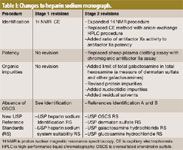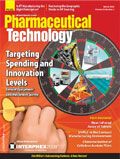Inside USP: Heparin Monographs Further Revised
USP's Stage 2 heparin monograph revisions address identification, potency, and impurities.
In January 2008, the US Centers for Disease Control and Prevention (CDC), along with the Food and Drug Administration, began a nationwide investigation of adverse health events associated with the use of heparin. FDA confirmed that serious injuries and hundreds of deaths have been associated with heparin, a blood-thinning drug that had been manufactured with an active pharmaceutical ingredient (API) sourced from China (1). In February 2008, Baxter Healthcare recalled multidose and single-dose vials of heparin sodium for injection, as well as "HEP-Lock" heparin flush products. During this investigation, FDA scientists identified a previously unknown contaminant, oversulfated chondroitin sulfate (OSCS), in the heparin (2).

Stockbyte/Getty Images
In response to this public health crisis, the US Pharmacopeial Convention (USPC), in collaboration with FDA, manufacturers, and other stakeholders, revised the USP heparin monographs. The revision took place in two stages in order to better protect the US heparin supply and to help prevent future adulteration. To address the immediate public health risk, Stage 1 monograph revisions, completed in June 2008, consisted of validating and implementing proton nuclear magnetic resonance spectroscopy (1H NMR) and capillary electrophoresis (CE) procedures initially developed at FDA to detect OSCS. Stage 2 proposed monograph revisions include new Identification, Potency, and Impurity tests to better control the quality of heparin API.
Stage 1: Immediate response
The Stage 1 monograph revisions of heparin sodium and heparin calcium incorporated FDA's analytical methods for identifying OSCS in heparin: 1 H NMR and CE. USPC laboratories validated these methods according to procedures outlined in General Information Chapter <1225> Validation of Compendial Procedures (3). In addition, USPC proposed appropriate system suitability criteria and specifications and developed two new reference standards (RS) to support the revised monographs: USP heparin sodium identification reference standard (RS) and USP heparin sodium system suitability RS.
The revised monographs were posted June 18, 2008, on the USPC website (www.usp.org) as Revision Bulletins and became official immediately. These monographs are referenced on the FDA website as well and have played an important role in controlling the quality of heparin API in the US (1).
Before posting the heparin Revision Bulletins, USPC solicited feedback from stakeholders by hosting two online meetings in spring 2008. Industry comments as well as submissions of new and improved analytical methods for characterization of heparin were critical in shaping the next stage of the monograph revision.
Stage 2: Comprehensive modernization
USPC and involved stakeholders realized that a thorough modernization of the existing monographs would be needed to effectively ensure the continuing quality of heparin. With this objective, USPC has undertaken a second stage of revisions that will completely revise the heparin sodium monograph (see Table I).

Table I: Changes to heparin sodium monograph.
The USPC Heparin Ad Hoc Advisory Panel played a critical role in revising the heparin sodium monograph and updating the associated specifications. The panel consists of industry, academia, and regulatory experts from around the world and is advisory to USP's Biologics & Biotechnology Blood and Blood Products Expert Committee (BBP EC), which is part of USPC's Council of Experts. Working closely with FDA, panel members reviewed numerous submissions regarding new and improved analytical procedures for the characterization of heparin. These procedures first were evaluated for suitability as compendial methods, and when needed, further validation work was carried out.
Identification. Public feedback on the Stage 1 1H NMR method generally was positive, but commenters also recommended that USPC state a clear pass/fail criterion while expanding the procedure to cover the entire spectral range. The revised procedure covers a spectral window of at least 10 to–2 ppm and requires identification of four main heparin signals: H1 of N-acetylated glucosamine (GlcNAc)/N-sulfated glucosamine, 6S (signal 1), H1 of iduronic acid 2S (signal 2), H2 of N-sulfated glucosamine S (signal 3), and methyl H of GlcNAc (signal 4). In addition, clear acceptance criteria are spelled out to control both known and potential contaminants in heparin.
Based on public comments, the advisory panel recommended replacing the CE procedure with an anion-exchange high-performance liquid chromatography (HPLC) procedure that provides higher resolution between heparin and other impurities. Another consideration favoring the change is the wide availability of HPLC instruments.
The third Identification test that has been introduced is Antifactor Xa to Antifactor IIa Ratio. This ratio of activities is routinely used to characterize unfractionated heparin as well as to distinguish different forms of low-molecular weight heparins. For high-quality heparin, the ratio of anti-factor Xa to antifactor IIa should be not less than 0.9 and not more than 1.1. Manufacturers must perform all Identification tests because they serve orthogonal purposes.
Potency. The pharmacopeial heparin potency assay traditionally was performed using sheep plasma. The rationale for this method is that it resembles as closely as possible the actual situation in which heparin typically is used (i.e., in human blood). Unfortunately, the results of the assay in plasma are affected by other proteins that are present in sheep plasma. Heparin can bind to a large variety of plasma proteins such as histidine-rich glycoprotein, platelet factor 4 (PF-4), and heparin cofactor II (HCII). The large enhancement of antifactor IIa activity for OSCS is an HCII-mediated event (4). This phenomenon explains how contaminated heparin batches successfully passed the USP sheep plasma clotting activity assay. Based on the known modes of action of heparin, USPC proposes to replace the current potency assay based on sheep plasma with a chromogenic antifactor IIa assay that uses purified reagents.
Organic impurities. An Impurity test has been added to quantify the percent galactosamine of total hexosamine in heparin. Heparins are salts of sulfated glucosamino-glycans composed of polymers of alternating D-glucosamine (N-sulfated or N-acetylated) and uronic acid (L-iduronic or D-glucuronic acid) joined by glycosidic linkages. This procedure involves the hydrolysis of heparin into the monomers (galactosamine and glucosamine) by hydrochloric acid and analysis by high-performance ion chromatography. The percent (w/w) of galactosamine with respect to the total amount of both galactosamine and glucosamine (hexosamine) is quantified using the relative response of galactosamine to glucosamine from the chromatograph's peak areas. This test provides a measure of dermatan sulfate and other galactosamine-containing impurities in heparin.
A quantitative Lowry method has replaced the old turbidity test for protein impurities. Nucleotidic impurities and residual solvents have been added to control residual DNA and residual-solvent levels in heparin.
Conclusion
The proposed heparin sodium and heparin sodium injection monographs were posted on the USPC website on Feb. 4, 2009. These Stage 2 monographs will be presented in the March–April Pharmacopeial Forum as proposed Interim Revision Announcements. After review of comments and approval by the BBP EC, the new heparin monographs are expected to become official Aug. 1, 2009.
USPC plans to ensure that any revisions to the monographs are suitable and will not disrupt the supply of safe and effective medicines for patients. Comments on the standards should be sent to heparin@usp.org by May 15, 2009.
Anita Y. Szajek, PhD,* is senior scientist, Tina S. Morris, PhD, is director of biologics & biotechnology, William F. Koch, PhD, is chief metrology officer, Darrell R. Abernethy, MD, PhD, is chief science officer, and Roger L. Williams, MD, is chief executive officer, all at the US Pharmacopeia, 12601 Twinbrook Parkway, Rockville, MD 20852-1790, tel. 301.816.8325; aey@usp.org.
*To whom all correspondence should be addressed.
References
1. FDA, "Information on Heparin (2009)," www.fda.gov/cder/drug/infopage/heparin/default.htm, accessed Jan. 29, 2009.
2. M. Guerrini et al., "Oversulfated Chondroitin Sulfate Is a Contaminant in Heparin Associated with Adverse Clinical Events," Nature Biotechnol. 26 (6), 669–675 (2008).
3. USP 31–NF 26 <1225>, "Validation of Compendial Procedures," 683–687 (2008).
4. T. Maruyama et al., "Conformational Changes and Anticoagulation Activity of Chondroitin Sulfate Following its O-Sulfonation," Carbohydr. Res., 306, 35–43 (1998).

Drug Solutions Podcast: A Closer Look at mRNA in Oncology and Vaccines
April 30th 2024In this episode fo the Drug Solutions Podcast, etherna’s vice-president of Technology and Innovation, Stefaan De Koker, discusses the merits and challenges of using mRNA as the foundation for therapeutics in oncology as well as for vaccines.
Pharmaceutical Tariffs Are Imminent: How Industry is Bracing for Impact
April 16th 2025On April 14, 2025, the Trump Administration launched a national security-driven investigation into pharmaceuticals, a move that will likely result in tariffs being placed on pharmaceutical drugs, ingredients, and other components that are imported from outside of the United States.